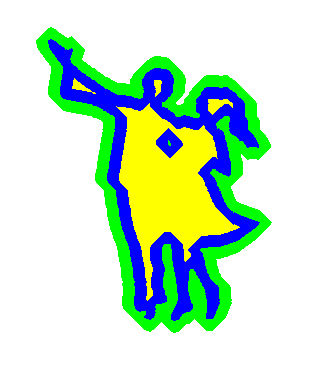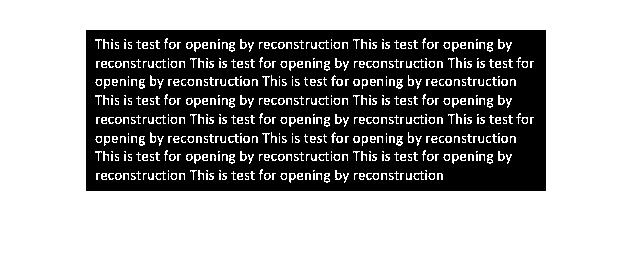|
Top-hat Transform
In mathematical morphology and digital image processing, a top-hat transform is an operation that extracts small elements and details from given images. There exist two types of top-hat transform: the ''white top-hat transform'' is defined as the difference between the input image and its opening by some structuring element, while the ''black top-hat transform'' is defined dually as the difference between the closing and the input image. Top-hat transforms are used for various image processing tasks, such as feature extraction, background equalization, image enhancement, and others. Mathematical definitions Let f:E\mapsto \mathbb be a grayscale image, mapping points from a Euclidean space or discrete grid ''E'' (such as \mathbb^2 or \mathbb^2) into the real line. Let b(x) be a structuring element of grayscale. Then, the white top-hat transform of ''f'' is given by: :T_w(f)=f-f \circ b, where \circ denotes the opening operation. The black top-hat transform of ''f'' (sometimes ... [...More Info...] [...Related Items...] OR: [Wikipedia] [Google] [Baidu] |
Mathematical Morphology
Mathematical morphology (MM) is a theory and technique for the analysis and processing of geometrical structures, based on set theory, lattice theory, topology, and random functions. MM is most commonly applied to digital images, but it can be employed as well on graphs, surface meshes, solids, and many other spatial structures. Topological and geometrical continuous-space concepts such as size, shape, convexity, connectivity, and geodesic distance, were introduced by MM on both continuous and discrete spaces. MM is also the foundation of morphological image processing, which consists of a set of operators that transform images according to the above characterizations. The basic morphological operators are erosion, dilation, opening and closing. MM was originally developed for binary images, and was later extended to grayscale functions and images. The subsequent generalization to complete lattices is widely accepted today as MM's theoretical foundation. History Mathemati ... [...More Info...] [...Related Items...] OR: [Wikipedia] [Google] [Baidu] |
Digital Image Processing
Digital image processing is the use of a digital computer to process digital images through an algorithm. As a subcategory or field of digital signal processing, digital image processing has many advantages over analog image processing. It allows a much wider range of algorithms to be applied to the input data and can avoid problems such as the build-up of noise and distortion during processing. Since images are defined over two dimensions (perhaps more) digital image processing may be modeled in the form of multidimensional systems. The generation and development of digital image processing are mainly affected by three factors: first, the development of computers; second, the development of mathematics (especially the creation and improvement of discrete mathematics theory); third, the demand for a wide range of applications in environment, agriculture, military, industry and medical science has increased. History Many of the techniques of digital image processing, or digita ... [...More Info...] [...Related Items...] OR: [Wikipedia] [Google] [Baidu] |
Image
An image is a visual representation of something. It can be two-dimensional, three-dimensional, or somehow otherwise feed into the visual system to convey information. An image can be an artifact, such as a photograph or other two-dimensional picture, that resembles a subject. In the context of signal processing, an image is a distributed amplitude of color(s). In optics, the term “image” may refer specifically to a 2D image. An image does not have to use the entire visual system to be a visual representation. A popular example of this is of a greyscale image, which uses the visual system's sensitivity to brightness across all wavelengths, without taking into account different colors. A black and white visual representation of something is still an image, even though it does not make full use of the visual system's capabilities. Images are typically still, but in some cases can be moving or animated. Characteristics Images may be two or three-dimensional, such as a ph ... [...More Info...] [...Related Items...] OR: [Wikipedia] [Google] [Baidu] |
Opening (morphology)
In mathematical morphology, opening is the dilation of the erosion of a set A by a structuring element B: :A\circ B = (A\ominus B)\oplus B, \, where \ominus and \oplus denote erosion and dilation, respectively. Together with closing, the opening serves in computer vision and image processing as a basic workhorse of morphological noise removal. Opening removes small objects from the foreground (usually taken as the bright pixels) of an image, placing them in the background, while closing removes small holes in the foreground, changing small islands of background into foreground. These techniques can also be used to find specific shapes in an image. Opening can be used to find things into which a specific structuring element can fit (edges, corners, ...). One can think of ''B'' sweeping around the inside of the boundary of ''A'', so that it does not extend beyond the boundary, and shaping the ''A'' boundary around the boundary of the element. Properties * Opening is idempotent ... [...More Info...] [...Related Items...] OR: [Wikipedia] [Google] [Baidu] |
Structuring Element
In mathematical morphology, a structuring element is a shape, used to probe or interact with a given image, with the purpose of drawing conclusions on how this shape fits or misses the shapes in the image. It is typically used in morphological operations, such as dilation, erosion, opening, and closing, as well as the hit-or-miss transform. According to Georges Matheron, knowledge about an object (e.g., an image) depends on the manner in which we probe (observe) it.See ( Dougherty 1992), chapter 1, page 1. In particular, the choice of a certain structuring element for a particular morphological operation influences the information one can obtain. There are two main characteristics that are directly related to structuring elements: * Shape. For example, the structuring element can be a "ball" or a line; convex or a ring, etc. By choosing a particular structuring element, one sets a way of differentiating some objects (or parts of objects) from others, according to their shape or spa ... [...More Info...] [...Related Items...] OR: [Wikipedia] [Google] [Baidu] |
Closing (morphology)
In mathematical morphology, the closing of a set (binary image) ''A'' by a structuring element ''B'' is the erosion (morphology), erosion of the dilation (morphology), dilation of that set, :A\bullet B = (A\oplus B)\ominus B, \, where \oplus and \ominus denote the dilation and erosion, respectively. In image processing, closing is, together with opening (morphology), opening, the basic workhorse of morphological signal noise, noise removal. Opening removes small objects, while closing removes small holes. Properties * It is idempotent, that is, (A\bullet B)\bullet B=A\bullet B. * It is increasing, that is, if A\subseteq C, then A\bullet B \subseteq C\bullet B. * It is ''extensive'', i.e., A\subseteq A\bullet B. * It is Translational invariance, translation invariant. See also *Mathematical morphology *Dilation (morphology), Dilation *Erosion (morphology), Erosion *Opening (morphology), Opening *Top-hat_transform, Top-hat transformation Bibliography * ''Image Analysis and Mat ... [...More Info...] [...Related Items...] OR: [Wikipedia] [Google] [Baidu] |
Feature Extraction
In machine learning, pattern recognition, and image processing, feature extraction starts from an initial set of measured data and builds derived values (features) intended to be informative and non-redundant, facilitating the subsequent learning and generalization steps, and in some cases leading to better human interpretations. Feature extraction is related to dimensionality reduction. When the input data to an algorithm is too large to be processed and it is suspected to be redundant (e.g. the same measurement in both feet and meters, or the repetitiveness of images presented as pixels), then it can be transformed into a reduced set of features (also named a feature vector). Determining a subset of the initial features is called feature selection. The selected features are expected to contain the relevant information from the input data, so that the desired task can be performed by using this reduced representation instead of the complete initial data. General Feature extractio ... [...More Info...] [...Related Items...] OR: [Wikipedia] [Google] [Baidu] |
Image Enhancement
Image editing encompasses the processes of altering images, whether they are digital photographs, traditional photo-chemical photographs, or illustrations. Traditional analog image editing is known as photo retouching, using tools such as an airbrush to modify photographs or editing illustrations with any traditional art medium. Graphic software programs, which can be broadly grouped into vector graphics editors, raster graphics editors, and 3D modelers, are the primary tools with which a user may manipulate, enhance, and transform images. Many image editing programs are also used to render or create computer art from scratch. The term “image editing” usually refers only to the editing of 2D images, not 3D ones. Basics of image editing Raster images are stored in a computer in the form of a grid of picture elements, or pixels. These pixels contain the image's color and brightness information. Image editors can change the pixels to enhance the image in many ways. The ... [...More Info...] [...Related Items...] OR: [Wikipedia] [Google] [Baidu] |
Grayscale
In digital photography, computer-generated imagery, and colorimetry, a grayscale image is one in which the value of each pixel is a single sample representing only an ''amount'' of light; that is, it carries only intensity information. Grayscale images, a kind of black-and-white or gray monochrome, are composed exclusively of shades of gray. The contrast ranges from black at the weakest intensity to white at the strongest. Grayscale images are distinct from one-bit bi-tonal black-and-white images, which, in the context of computer imaging, are images with only two colors: black and white (also called ''bilevel'' or '' binary images''). Grayscale images have many shades of gray in between. Grayscale images can be the result of measuring the intensity of light at each pixel according to a particular weighted combination of frequencies (or wavelengths), and in such cases they are monochromatic proper when only a single frequency (in practice, a narrow band of frequencies) is ca ... [...More Info...] [...Related Items...] OR: [Wikipedia] [Google] [Baidu] |
Euclidean Space
Euclidean space is the fundamental space of geometry, intended to represent physical space. Originally, that is, in Euclid's Elements, Euclid's ''Elements'', it was the three-dimensional space of Euclidean geometry, but in modern mathematics there are Euclidean spaces of any positive integer dimension (mathematics), dimension, including the three-dimensional space and the ''Euclidean plane'' (dimension two). The qualifier "Euclidean" is used to distinguish Euclidean spaces from other spaces that were later considered in physics and modern mathematics. Ancient History of geometry#Greek geometry, Greek geometers introduced Euclidean space for modeling the physical space. Their work was collected by the Greek mathematics, ancient Greek mathematician Euclid in his ''Elements'', with the great innovation of ''mathematical proof, proving'' all properties of the space as theorems, by starting from a few fundamental properties, called ''postulates'', which either were considered as eviden ... [...More Info...] [...Related Items...] OR: [Wikipedia] [Google] [Baidu] |
Lattice Graph
In graph theory, a lattice graph, mesh graph, or grid graph is a graph whose drawing, embedded in some Euclidean space , forms a regular tiling. This implies that the group of bijective transformations that send the graph to itself is a lattice in the group-theoretical sense. Typically, no clear distinction is made between such a graph in the more abstract sense of graph theory, and its drawing in space (often the plane or 3D space). This type of graph may more shortly be called just a lattice, mesh, or grid. Moreover, these terms are also commonly used for a finite section of the infinite graph, as in "an 8 × 8 square grid". The term lattice graph has also been given in the literature to various other kinds of graphs with some regular structure, such as the Cartesian product of a number of complete graphs. Square grid graph A common type of a lattice graph (known under different names, such as square grid graph) is the graph whose vertices correspond to the p ... [...More Info...] [...Related Items...] OR: [Wikipedia] [Google] [Baidu] |
Opening (morphology)
In mathematical morphology, opening is the dilation of the erosion of a set A by a structuring element B: :A\circ B = (A\ominus B)\oplus B, \, where \ominus and \oplus denote erosion and dilation, respectively. Together with closing, the opening serves in computer vision and image processing as a basic workhorse of morphological noise removal. Opening removes small objects from the foreground (usually taken as the bright pixels) of an image, placing them in the background, while closing removes small holes in the foreground, changing small islands of background into foreground. These techniques can also be used to find specific shapes in an image. Opening can be used to find things into which a specific structuring element can fit (edges, corners, ...). One can think of ''B'' sweeping around the inside of the boundary of ''A'', so that it does not extend beyond the boundary, and shaping the ''A'' boundary around the boundary of the element. Properties * Opening is idempotent ... [...More Info...] [...Related Items...] OR: [Wikipedia] [Google] [Baidu] |




